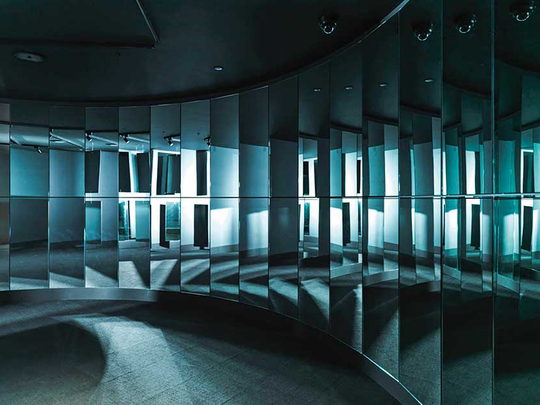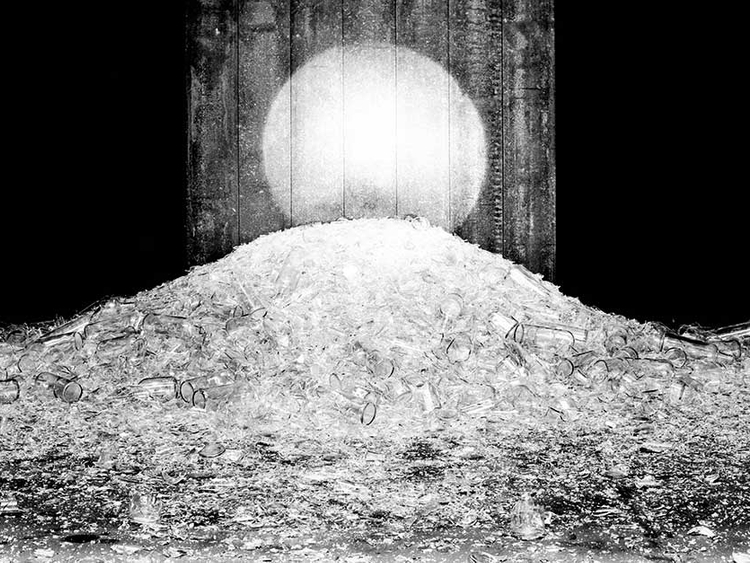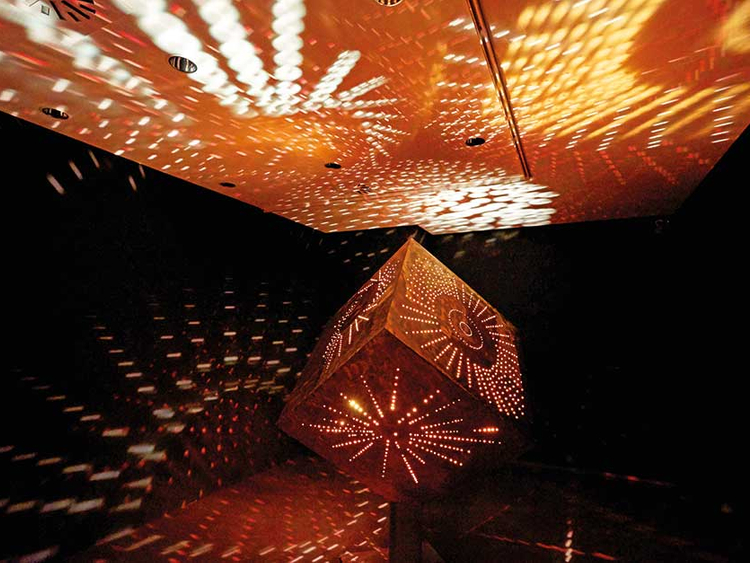
When Otto Piene was a teenager in Germany during the Second World War, German citizens were ordered to black out windows so allied aircraft couldn’t see them.
It was impossible to black them out entirely, though, and during the day the sun would shine through tiny cracks and chinks in the window coverings. Years later, when the violence and anxiety of the war had subsided and only the ruins remained, Piene would say that when he dreamed about a better life, that better life was represented by the sun — seeing it, feeling it flood a room.
Mattijs Visser, founder of the Zero Foundation, tells this story by way of explaining a work of Piene’s, Pirouetten (Pirouettes in English). The artwork is a giant brass cube, about a metre along each edge, its sides peppered with holes in the pattern of suns and stars. It is strung up from the ceiling by one corner while a lamp turns slowly inside it, casting not shadows but moving patterns of light on the surfaces of the room. Piene called them “light ballets”, collaborating on them with composers including Karlheinz Stockhausen and John Cage.
At the end of the war, nearly all the public buildings in Dusseldorf, Piene’s hometown, were destroyed. In the late 1950s he joined with two other German artists who were also “looking for the same light”: Heinz Mack and Gunther Uecker. Over eight years they would pull into their orbit Yves Klein, Yayoi Kusama, Marcel Duchamp and more than 100 other artists whose work intersected or sympathised with their own.
Zero, the artistic tendency that developed as a consequence — named for the point of beginning, the origin — was not simply about desiring a new kind of art, but a new kind of world.
The Zero movement — or “dynamic” as Visser calls it — has slipped under the radar for many years but the past decade has seen a growing interest in the vision and works of those artists. In 2014 the Guggenheim staged a large retrospective, with the Stedelijk museum in Amsterdam following in 2015. And a new Zero exhibition is now showing at the Museum of Old and New Art (Mona) in Tasmania, coinciding with this year’s Dark Mofo arts festival.
Mona’s exhibition might be a “filler” — the originally scheduled artist pulled out just nine months ago — but you wouldn’t know it if Mona’s founder, David Walsh, hadn’t said so. The work feels remarkably contemporary for pieces created in the 1950s and 1960s — the metallics, mirrors, careful use of light and stark simplicity of many of the works suit Mona’s black walls and its underground aesthetic.
There is a real democratic sensibility to many of the works. “They were strongly against ‘the artist, his hand’. They had to free themselves from this,” Visser says. Sometimes this meant works were not transported for exhibition but rather recreated onsite by assistants or friends who would follow an artist’s instructions using materials that were on hand. In one display at Mona, hundreds of identical plastic bags — the kind you might take a goldfish home in — are filled with water and pinned to the wall, illuminated by a spotlight in one corner. The installation was created with new materials by following instructions left by Hank Peeters.
Sometimes it meant collaborative works. Visser gives the example of Lucio Fontana, who painted a canvas which he then sent to the Belgian artist Jef Verheyen, who painted over it before sending it to Hermann Goepfert in Frankfurt. Goepfert created a metal structure for the canvas before Verheyen came to Frankfurt to poke some holes in it. When works were sold, the funds were shared.
“They didn’t care who made it, who signed it, who produced it,” says Visser. “If somebody could sell it, wonderful. He would put it in the pot and they would live from that.”
Many of the works at Mona require activation or movement from the viewer, such as Christian Megert’s Spiegelenvironment (mirror environment), a curved wall of mirrors illuminated by spotlight. Depending on where you stand, you see yourself in every mirror - or in none. “There’s a moment where you’re completely blinded, so you open your eyes, and you start again, you start seeing again,” Visser says. (This work would inspire Yayoi Kusama to create her own mirror rooms.)
The artists used what was available to them — everyday objects such as wood, nails, matches and fabric. At the same time they were fascinated by newness and new materials — aluminium, plexiglass, plastic — and they wanted to throw off the shackles of artistic tradition. By using new materials, by pushing into performance, by getting away from the idea of art as an object you hang on the wall, Zero was paving the way for what we now call installation art.
Mack and Piene would host themed exhibitions that would last for a single evening. They also published magazines that explored their ideas in more detail. They crossed borders — geographic and linguistic — creating connections with artists all around the world. And there were plenty of likeminded people: in Japan, a group that also called themselves Zero had started, completely independently, in 1953. There was also a Zero group in the Netherlands, founded also without any idea there were others doing so, in 1958 — the same year Mack and Piene were publishing their first Zero magazine. They had more than just a name in common: they also had a point of view.
Mack wrote about the concept of “resting restlessness” — “this idea of art being something that wasn’t static, something that broke boundaries,” says the curator, Jane Clark. In Gunther Uecker’s Lichtregen (light rain), slender aluminium poles hang from the ceiling, inserted with fluorescent globes. Lichtregen was intended to invoke the natural world but through a feeling rather than a direct representation.
In Adolf Luther’s bottle smashing room (in German, Flaschenzerschlagungsraum), participants hurl identical glass bottles at a metal plate set against a wall. When the bottle smashes, a flash of light bursts across the room, while the broken glass creates a mound against the wall. While the effect of the remnants has its own beauty, says Clark, the artwork is in the act of smashing.
There weren’t many galleries with an interest in Zero so the artists’ ability to show their work depended on very practical things like a fast car and money for fuel, as well as works being either small enough to transport in the back seat, or simple enough to recreate anywhere. They also relied on likeminded people who would understand the spirit of what they were doing.
“Otto Piene was asked how many people were in the group or the movement,” says Visser. “He said, it’s not a group. It’s not a movement. There’s no precedent; there is no manifest; there is no dogma. There is a vision.”
The “vision” dissolved in 1966. The artists threw a party to farewell it.
“I think some of the reason they split up in the end was because actually their ideals, and their ideas, really diverged,” Clark says. “I think they were quite conscious that you can’t push a good thing too long, it loses its energy.”
Visser founded the Zero Foundation in 2011, with those Zero artists who were still alive, to preserve and revitalise their work - and continue to experiment in their spirit.
“If the artists would come here to the exhibition, they would say, ‘Yeah, we would have done it in the same way’.”
–Guardian News & Media Ltd
Zero reimagined is at Mona in Hobart, Tasmania, until April 22, 2019.

















